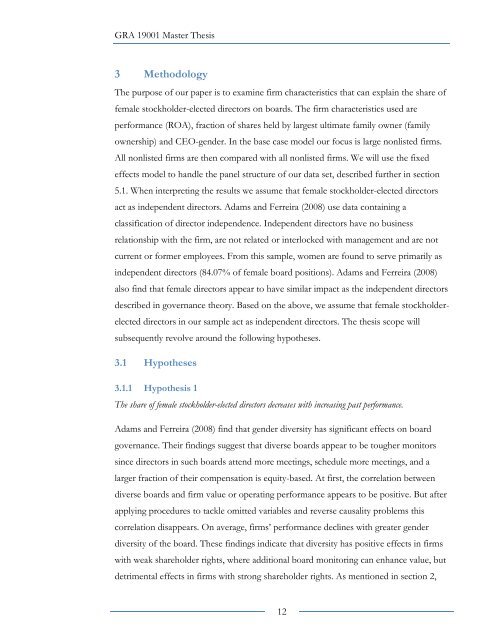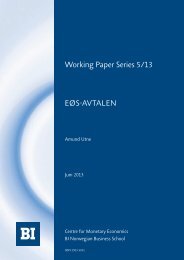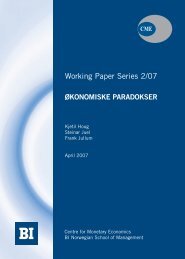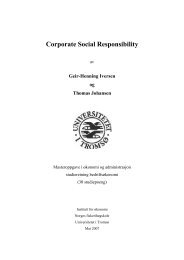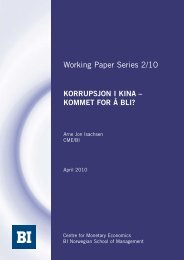Gender Diversity on the Board - BI Norwegian Business School
Gender Diversity on the Board - BI Norwegian Business School
Gender Diversity on the Board - BI Norwegian Business School
You also want an ePaper? Increase the reach of your titles
YUMPU automatically turns print PDFs into web optimized ePapers that Google loves.
GRA 19001 Master Thesis<br />
3 Methodology<br />
The purpose of our paper is to examine firm characteristics that can explain <strong>the</strong> share of<br />
female stockholder-elected directors <strong>on</strong> boards. The firm characteristics used are<br />
performance (ROA), fracti<strong>on</strong> of shares held by largest ultimate family owner (family<br />
ownership) and CEO-gender. In <strong>the</strong> base case model our focus is large n<strong>on</strong>listed firms.<br />
All n<strong>on</strong>listed firms are <strong>the</strong>n compared with all n<strong>on</strong>listed firms. We will use <strong>the</strong> fixed<br />
effects model to handle <strong>the</strong> panel structure of our data set, described fur<strong>the</strong>r in secti<strong>on</strong><br />
5.1. When interpreting <strong>the</strong> results we assume that female stockholder-elected directors<br />
act as independent directors. Adams and Ferreira (2008) use data c<strong>on</strong>taining a<br />
classificati<strong>on</strong> of director independence. Independent directors have no business<br />
relati<strong>on</strong>ship with <strong>the</strong> firm, are not related or interlocked with management and are not<br />
current or former employees. From this sample, women are found to serve primarily as<br />
independent directors (84.07% of female board positi<strong>on</strong>s). Adams and Ferreira (2008)<br />
also find that female directors appear to have similar impact as <strong>the</strong> independent directors<br />
described in governance <strong>the</strong>ory. Based <strong>on</strong> <strong>the</strong> above, we assume that female stockholderelected<br />
directors in our sample act as independent directors. The <strong>the</strong>sis scope will<br />
subsequently revolve around <strong>the</strong> following hypo<strong>the</strong>ses.<br />
3.1 Hypo<strong>the</strong>ses<br />
3.1.1 Hypo<strong>the</strong>sis 1<br />
The share of female stockholder-elected directors decreases with increasing past performance.<br />
Adams and Ferreira (2008) find that gender diversity has significant effects <strong>on</strong> board<br />
governance. Their findings suggest that diverse boards appear to be tougher m<strong>on</strong>itors<br />
since directors in such boards attend more meetings, schedule more meetings, and a<br />
larger fracti<strong>on</strong> of <strong>the</strong>ir compensati<strong>on</strong> is equity-based. At first, <strong>the</strong> correlati<strong>on</strong> between<br />
diverse boards and firm value or operating performance appears to be positive. But after<br />
applying procedures to tackle omitted variables and reverse causality problems this<br />
correlati<strong>on</strong> disappears. On average, firms’ performance declines with greater gender<br />
diversity of <strong>the</strong> board. These findings indicate that diversity has positive effects in firms<br />
with weak shareholder rights, where additi<strong>on</strong>al board m<strong>on</strong>itoring can enhance value, but<br />
detrimental effects in firms with str<strong>on</strong>g shareholder rights. As menti<strong>on</strong>ed in secti<strong>on</strong> 2,<br />
12


